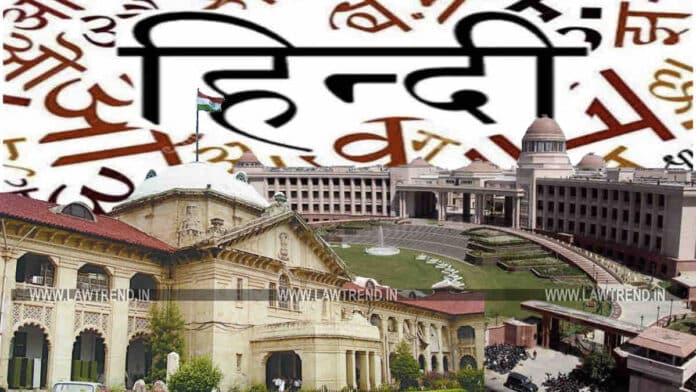The High Court of Judicature at Allahabad, while dismissing a criminal appeal on its merits, has taken strong judicial notice of the “classic example” of an improperly written trial court judgment that was “partially in English and partially in Hindi,” with some lines even being “half in Hindi and half in English.”
A Division Bench comprising Justice Ajay Kumar-II and Justice Rajeev Misra held that this practice defeats the very purpose of the bilingual system. The Bench has directed that its judgment be circulated to all Judicial Officers in Uttar Pradesh and that the matter be placed before the Hon’ble Chief Justice “for taking action desirable in present case.”
The observations were made in a judgment dated October 29, 2025, after the Bench had dismissed Criminal Appeal U/S 413 BNSS No. 600 of 2025. The appeal, filed by an informant, challenged the acquittal of his son-in-law on charges of dowry death (Sec 304-B IPC) and cruelty (Sec 498-A IPC) passed by the Additional District & Sessions Judge, Agra. After upholding the acquittal on merits, the High Court turned its attention to the structure of the trial court’s judgment.
High Court’s Observations on the Trial Court Judgment
The High Court, in the judgment dictated by Hon’ble Dr. Ajay Kumar-II, J., noted that the trial court’s order was a “classic example of writing judgment which is partially English and partially Hindi.”
The Bench provided a statistical breakdown:
“The judgment is running in 54 pages with total of 199 paragraphs. 63 paragraphs are in English and 125 paragraphs are in Hindi and the rest 11 paragraphs are in both languages.”
The Court expressed further concern that “In 11 paragraphs, in which, both Hindi and English, languages have been used, surprisingly, there are certain lines, which are half in Hindi and half in English.”
To illustrate this point, the High Court reproduced several paragraphs from the impugned judgment, which showed an indiscriminate mixing of Hindi and English text and legal citations within the same sentences and paragraphs.
The Purpose of Hindi in Judgments
The High Court elaborated on the official rules and objectives regarding the language of subordinate courts in Uttar Pradesh, which is a “Hindi speaking State.”
The Bench observed:
“The State of Uttar Pradesh is a Hindi speaking State and majority of the population is Hindi speaking. Therefore, the very objective of writing judgments in Hindi in State of Uttar Pradesh is that ordinary litigant can understand the judgment written by the court and also the reasons assigned by the court for either allowing or rejecting his/her claim.”
The Court held that the practice of mixing languages directly frustrates this objective:
“When a judgment is partially written in English and partially in Hindi, the very objective of writing down judgment in Hindi, in a Hindi speaking State would frustrate, as an ordinary person only knowing Hindi language, will not be able to decipher the reasons and logic given by the trial Judge in a judgement written in English.”
The ‘Bilingual System’ Explained
The High Court clarified the scope of the “bilingual system” (G.L. No. 8/X-e-5, dated 11th August, 1951) currently in place, which allows Presiding Officers to write their judgments “either in Hindi or in English.”
However, the Court explicitly stated that this “cannot be construed to write a judgment partially in English and partially in Hindi.”
The Bench did outline a permissible exception:
“If a judgment is written in Hindi and Judicial Officer is relying upon certain specific part and/or excerpt of the judgment of High Court or Apex Court, then certainly, he is at liberty to quote such portion… in English.”
Similarly, the Court noted, if a judgment is written in English, evidence recorded in Hindi (like a dying declaration) can be quoted verbatim. However, in both scenarios, the High Court placed a condition: “the concerned Presiding Officer is however under an obligation to translate the same from Hindi to English or English to Hindi, as the case may be.”
Directives Issued by the High Court
Concluding its observations, the Bench issued a broad directive hoping to correct this practice:
“We hope and trust that the Judicial Officers across the State of Uttar Pradesh will write down their judgments either in Hindi or in English as observed above. A copy of this judgment be circulated amongst all Judicial Officers of State of Uttar Pradesh through Registrar (compliance).”
Furthermore, the Bench directed: “A copy of this judgment alongwith judgment of trial court be placed before Hon’ble the Chief Justice for taking action desirable in present case.”







